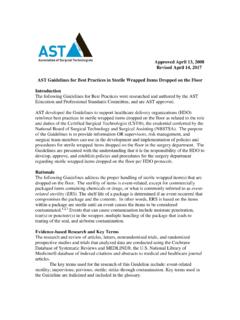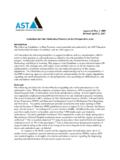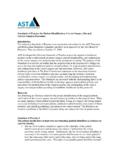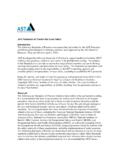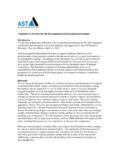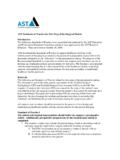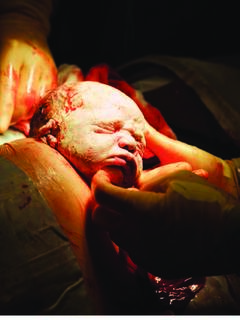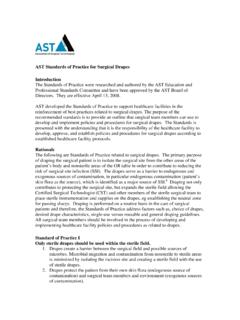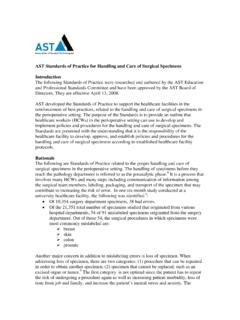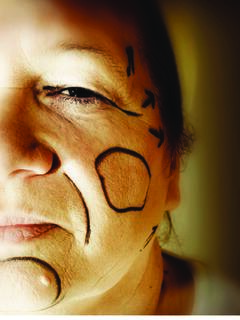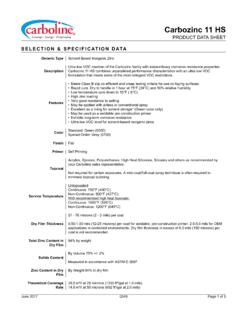Transcription of Revised June 2017 Guidelines for Best Practices for ...
1 1 Approved April 10, 2015 Revised june 2017 Guidelines for best Practices for humidity in the Operating Room Introduction The following Guidelines for best Practices were researched and authored by the AST Education and Professional Standards Committee, and are AST approved. AST developed the Guidelines to support healthcare delivery organization s (HDO) reinforce best Practices in humidity in the operating room (OR) as related to the role and duties of the Certified Surgical Technologist (CST ), the credential conferred by the National Board of Surgical Technology and Surgical Assisting.
2 The purpose of the Guidelines is to provide information OR supervisors, risk management and surgical team members can use in the development and implementation of policies and procedures for humidity in the surgery department. The Guidelines are presented with the understanding that it is the responsibility of the HDO to develop, approve, and establish policies and procedures for the surgery department regarding establishing humidity levels in the OR per HDO protocols. Rationale The maintenance of the required level of relative humidity (RH) in the operating room (OR) has been essential to control the growth of microorganisms, prevent electrostatic discharge (ESD), and comfort of the OR team.
3 Additionally, RH level is important to the shelf life of sterile supplies that are stored in the surgery department and the levels established by manufacturers of electro-medical devices. The subject of RH level involves a team of healthcare providers working together to identify the issues and develop solutions that includes CSTs, healthcare technology management (HTM; previously referred to as Biomedical technicians ), and RNs. In 2008 the American Society of Heating, Refrigeration, and Air Conditioning (ASHRAE) Revised its standard for the lower level of RH in the OR from 30% to 20% while still keeping the upper level of 60% in place (range now being 20% to 60%).
4 1 Starting with the 2012 edition, the National Fire Protection Association (NFPA) included the ASHRAE standard in the NFPA 99:Health Care Facilities Code and the Facility Guidelines Institute has also placed the standard in the Guidelines for Design and Construction of Hospitals and Outpatient , 3 In September 2010 the American Society for Healthcare Engineering (ASHE) submitted the Briefing for CMS on Reduction of Low-Level humidity in Short-Term Patient Care Subsequently, in April 2013, the Centers for Medicare & Medicaid Services (CMS) announced it had lowered the RH requirement for anesthetizing locations from a minimum of >35% to 20%.
5 4,5,6 This was the final step in opening the door for HDOs to set the lower end of RH for anesthetizing locations at 20%.4 As previously mentioned, 30% RH was established as an aid in controlling microbial growth in the OR, prevent ESD, and comfort of the OR team. However over time these concerns lessened in particular with the development and use of non-flammable anesthetic gases, improved 2 ventilation systems, and improved materials used in the manufacturing of sterile drapes and gowns reducing their flammability and contribution to ESD. The issue that has continued is the difficulty of maintaining the RH by HDOs that are located in regions of the country where cold weather and/or dry, desert-like conditions The dry environmental conditions present HDOs the challenge of maintaining a higher RH that is also affected by the use of air conditioning or heating.
6 The following is stated in the ASHE briefing to the CMS: In addition, RH is intimately tied to outdoor air conditions and local climate conditions. Many facilities in the United States are located in more arid climates or areas with variable seasons, which ambient local conditions often make maintaining a 30 percent RH impossible to achieve. 4 To achieve the higher level of RH HDOs report they often have to install additional expensive HVAC equipment that requires additional maintenance in order to maintain or increase the In the ASHE briefing to the CMS the following is stated: Without jeopardizing patient outcomes, the is change is estimated to save the health care industry more than $200 million in the next 10 years by reducing the initial ventilation system installation cost, eliminating the need to modernize existing systems to maintain 35 percent RH, and providing energy conservation savings.
7 4 In the summer of 2014 a CMS surveyor cited a hospital due to the RH level being lower than allowed as stated in the manufacturer s instructions for use (IFU) for certain sterile products being used in the OR. This brought to light an important oversight the change in the standard did not take into consideration the clinical impact that the lower RH could have on supplies and equipment used in anesthetizing locations including the IFUs. humidity affects the shelf life and product integrity of sterile supplies. Therefore, shelf life and product integrity can be even more greatly affected if the IFU calls for 30-60% RH, but the HDO lowers the RH to 20%.
8 Examples of products that are sensitive to humidity include biological and chemical indicators, and EKG electrodes. Manufacturer s test products at a specific RH, of which it can be assumed the testing level has been at 30%. If supplies are stored in the OR at a RH level different from the RH used during manufacturer testing, the shelf life could be affected, shortened. Which leads to the next challenge in that the only way for manufacturers to determine if the shelf life and integrity of sterile supplies is affected is to test at the lower RH; but this could involve manufacturers having to install testing equipment that provides the lower RH as well as allowing manufacturers a significant amount of time to test the myriad number of OR supplies at the lower RH.
9 The manufacturers of electro-medical devices (EMD) and healthcare technology management (HTM) have communicated concerns about lower RH levels. Problems with EMDs not working properly at lower RH levels have been reported by HTM technicians, and the lower levels causing problems with calibration. Of additional concern is lower RH levels contributing to the release of ESDs that are destructive to EMDs as well as posing a safety hazard to OR personnel. ESD discharges can damage EMD internal parts that can lead to device failure and/or malfunctioning. In the lower RH level environment, OR staff could have a tendency to more easily become charged and receive an electrostatic shock when coming into contact with an EMD.
10 But Dr. Farhad Memarzadeh, Director of the Division of Technical Resources at the National Institutes of Health, disputes the notion of an environmental hazard with the RH at a 20% level by indicating there have been no reported or documented cases of static electricity being an issue in providing safe environments for patients. Databases from FDA s Manufacturer and User Facility Device Experience (MAUDE) 3 report (FDA 2011) and Emergency Care Research Institute (ECRI) have been reviewed with no incidence of equipment malfunctions or fire due to static discharge. 8 Lastly, ESD can be a source of ignition completing the surgical fire triangle if the other sources are present: ignition source oxygen In regard to EMDs one last item to be taken into consideration many EMDs are considered capital equipment purchases with the intention that the device(s) will last many years.
